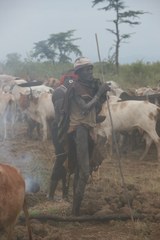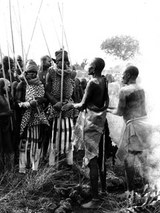Priests (Kômorena)
Kowlukoro Duli preparing to bless the herds at a 'Bio Lama' ceremony at Ulumholi in 2010.
The only formally defined leadership role in the society is that of Kômoru, or Priest, an inherited office which is principally of religious and ritual significance. The priest embodies in his person the well-being of the group as a whole and acts as a means of communication between the community and God (tumwi), especially when it is threatened by such events as drought, crop pests and disease. One clan in particular, Komorte, is considered to be, par excellence, the priestly clan. The priest currently in office in northern Mursiland (Dola), Ulikoro Konyonomora, is a member of this clan, as is his similarly named counterpart in the south, Ulikoro Bule.
The Bio Lama: An example of Priestly duties, which may be performed by a willing member of a Priestly family, is the bio lama. Bio lama literally means ‘rounding up the cattle’. While all ceremonies performed by the Priests are for the public benefit, this ceremony is also performed in public, and draws large crowds of people and cattle. At a bio lama, the well-being of the community, including human health, the cattle and the fertility of the land are all addressed, and rain may be asked for. Boys have to go to special areas to obtain a supply of various coloured clays, and to cut leafy branches from particular species of tree. The clay, mixed with water, is used to daub every member of the congregation, while the leaves, placed on the fire, would create smoke to “attract the attention of tumwi”. The bara age-grade construct a circle of stones nearby the Priest's settlement, within which the fire would be kindled. The ceremony, held a different phases of the lunar cycle, is spread out over four days, during which time goats or cattle may be sacrificed, the colours of which depend upon the priestly family. At a bio lama, people say ‘the land is healed/lives by treating the earth, and all problems are banished’. If it rains during or soon after the bio lama, people will remark on the powers of the Priest.
Ulikoro Konyonomora (Komor-a-kora) blessing duelling contestants. (David Turton, 1996)
At the death and instillation of a Priest: When a priest dies, his body is taken into his hut, and his successor stands outside the entrance to the hut and blows his oryx horn trumpet (joro). As the people begin to arrive, the heir's senior wife climbs onto the roof of the hut, holding a stick. The classificatory sister's sons of the priestly descent group try also to climb onto the hut, but they are driven back by the wife of the heir, while the latter remains standing at the hut's entrance. The sister's sons are attempting, unsuccessfully, to capture the mênêngi (“soul”) of the dead man to carry it off as their possession. At the burial of a Priest, his cattle are driven to the grave, and are said to weep for the dead Priest. Then, several animals are killed and eaten, and a grave is dug. The corpse is placed at the edge of the grave, and the heir climbs down into it. As he crouches in the grave, a goat is held over him while its throat is cut with a spear, so that the blood falls on the heir but not onto the corpse. While the heir remains crouching in the grave, the corpse is manoeuvred so that it is half in and half out of the grave. The corpse is buried, sewn in a cow skin, with its head facing the point on the Omo at which the Mursi made their first crossing from the right bank – namely Dorl (see oral text).
Upon the death of a Priest there is some indication that his children or relations take the earth from the grave or the clan’s sacred tree at the Omo (baddi); with this earth they are able to do ritual things, such as putting this earth on the fire at the communal healing ceremony called bio lama or ‘rounding up the cattle’. The relatives of the deceased Kômoru would go to “bha nene na amadonê bha, bangadi, baddi, na sheshegé bha, sheshegé logo, sheshegé logo”, describing how the children would visit their family place [at the Omo] and there they would ‘anoint’ with earth, and the earth of the termite mound (bangadi), and their sacred tree (baddi), and ‘re-align’ or ‘fine-tune’ (sheshegé) the earth and the knowledge. The formal installation of the new Priest may occur several years after the death of the former Priest. The instillation takes place at Dorl, the sacred site of the Mursi crossing on banks of the Omo River. At Dorl people perform a ceremony called kamack Kômoru, 'to take hold of the Priest’. People select their Kômoru based on the character of the man: someone exemplary, a respectful, cool headed, hospitable man, one who listens etc…It is said that were the community to select someone with a bad character, he would curse people.



